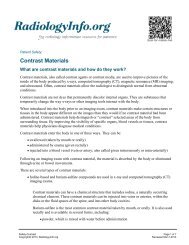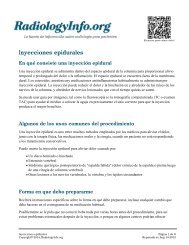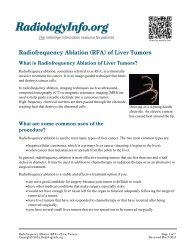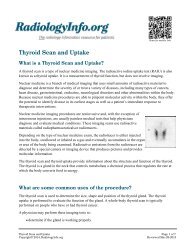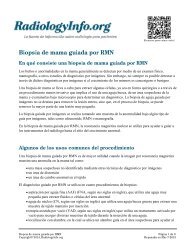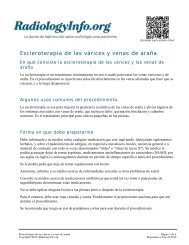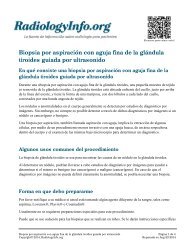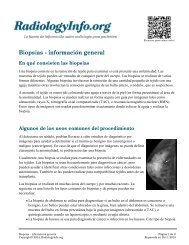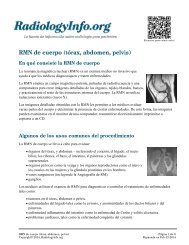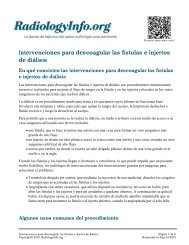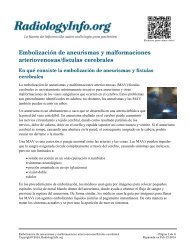Venography - RadiologyInfo
Venography - RadiologyInfo
Venography - RadiologyInfo
You also want an ePaper? Increase the reach of your titles
YUMPU automatically turns print PDFs into web optimized ePapers that Google loves.
There is a very slight risk of an allergic reaction if contrast material is injected.<br />
In rare cases, a venogram can cause a deep vein thrombosis.<br />
There is a risk of injury to the kidneys with contrast injection. Patients with impaired kidney (renal)<br />
function should be given special consideration before receiving iodine-based contrast materials by<br />
vein or artery. Such patients are at risk for developing contrast-induced nephropathy, in which the<br />
pre-existing kidney damage is worsened. See the Safety page<br />
(www.radiologyinfo.org/en/safety/index.cfm?pg=sfty_contrast) for more information about<br />
contrast materials.<br />
Any procedure that involves placement of a catheter inside a blood vessel carries certain risks.<br />
These risks include damage to the blood vessel, bruising or bleeding at the puncture site, and<br />
infection.<br />
There is always a slight chance of cancer from excessive exposure to radiation. However, the<br />
benefit of an accurate diagnosis far outweighs the risk.<br />
The effective radiation dose for this procedure varies. See the Safety page<br />
(www.<strong>RadiologyInfo</strong>.org/en/safety/) for more information about radiation dose.<br />
Because children are more sensitive to radiation exposure than adults, equipment and procedures<br />
will be monitored in order to deliver the lowest possible dose to young patients.<br />
A Word About Minimizing Radiation Exposure<br />
Special care is taken during x-ray examinations to use the lowest radiation dose possible while producing<br />
the best images for evaluation. National and international radiology protection organizations continually<br />
review and update the technique standards used by radiology professionals.<br />
Modern x-ray systems have very controlled x-ray beams and dose control methods to minimize stray<br />
(scatter) radiation. This ensures that those parts of a patient's body not being imaged receive minimal<br />
radiation exposure.<br />
What are the limitations of venography?<br />
The results of a venogram can be altered or affected if you are unable to sit still during the procedure<br />
since that will affect how the contrast material moves through your veins. Further exams may also be<br />
required if the more central veins located in the pelvis, abdomen and chest are not fully evaluated with<br />
contrast injection via an IV placed in the extremity.<br />
In some cases, ultrasound is a preferred procedure because it has fewer risks and side effects.<br />
Disclaimer<br />
This information is copied from the <strong>RadiologyInfo</strong> Web site (http://www.radiologyinfo.org) which is dedicated to<br />
providing the highest quality information. To ensure that, each section is reviewed by a physician with expertise in<br />
the area presented. All information contained in the Web site is further reviewed by an ACR (American College of<br />
Radiology) - RSNA (Radiological Society of North America) committee, comprising physicians with expertise in<br />
<strong>Venography</strong> Page 4 of 5<br />
Copyright© 2014, <strong>RadiologyInfo</strong>.org<br />
Reviewed Aug-5-2013



